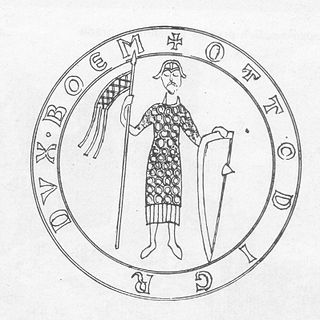
The Duchy of Bohemia, also later referred to in english as the Czech Duchy, was a monarchy and a principality of the Holy Roman Empire in Central Europe during the Early and High Middle Ages. It was formed around 870 by Czechs as part of the Great Moravian realm. The Bohemian lands separated from disintegrating Moravia after Duke Spytihněv swore fidelity to the East Frankish king Arnulf in 895.

Boleslaus II the Pious, a member of the Přemyslid dynasty, was Duke of Bohemia from 972 until his death

Vladislaus Henry, a member of the Přemyslid dynasty, was elected Duke of Bohemia in 1197 and Margrave of Moravia from 1197 until his death. He only served as duke during the year 1197 and was indeed the last ruler of Bohemia to hold that title. It was his brother Ottokar I, whose forces overthrew him, who finally achieved the elevation of the Duchy of Bohemia to the status of a kingdom starting in 1198.

VratislausII, the son of Bretislaus I and Judith of Schweinfurt, was the first King of Bohemia as of 15 June 1085, his royal title granted as a lifetime honorific from Holy Roman Emperor Henry IV that did not establish a hereditary monarchy. Before his elevation to the royal dignity, Vratislaus had ruled Bohemia as duke since 1061.

Vladislaus I was Duke of Bohemia from 1109 to 1117 and from 1120 until his death.

Svatopluk the Lion was Duke of Bohemia from 1107 until his assassination in 1109. His rule was overshadowed by the fierce conflict around the Bohemian throne in the 12th century.
Vladislaus II or Vladislaus I (king) was the second King of Bohemia from 1158. Before that, he had been Duke of Bohemia from 1140. When he abdicated in 1172, the royal title was not yet hereditary.

Frederick, a member of the Přemyslid dynasty, was Duke of Bohemia from 1172 to 1173 and again from 1178 to his death.

Conrad II Otto, a member of Přemyslid dynasty, was the first Margrave of Moravia from 1182 to 1189 and Duke of Bohemia from 1189 until his death.
Děpold I was the second son of Duke Vladislav I of Bohemia and brother of Duke and later King of Bohemia Vladislav II.
The history of Moravia, one of the Czech lands, is diverse and characterized by many periods of foreign governance.
Salomea of Berg was a German noblewoman and, by marriage with Prince Bolesław III Wrymouth in 1115, High Duchess of Poland until her husband's death in 1138.

Świętosława of Poland was the third wife of Duke Vratislaus II of Bohemia and the first Queen of Bohemia as of 1085.

The Battle of Chlumec was the culmination of a 12th-century war of succession in the Duchy of Bohemia. It occurred on 18 February 1126 in the vicinity of the village of Chlumec near Chabařovice on the southern slopes of the Eastern Ore Mountains. The Bohemian forces led by Duke Soběslav I defeated an Imperial contingent of troops under King Lothair III of Germany and his Moravian ally Duke Otto II the Black.
Udalrich of Olomouc was Duke in Hradec Králové from 1152 till 1153 and between 1173–1177 ruled the appanage of Olomouc, one of three ducal regions in Moravia, then part of the Duchy of Bohemia.

Conrad II of Znojmo, a member of the Přemyslid dynasty, was a Bohemian prince who ruled in the Moravian principality of Znojmo from 1123 to 1128 and again from 1134 until his death.




















